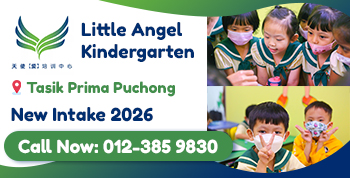I Can Read, Puchong Jaya
by on 02/08/2025 ...

Also available in : Bahasa Malaysia 中文版
|
Highlights |
|
Young children who can read and love reading have a whole lot going for them, don’t they? Reading, however, is a skill that should never be taken for granted, as many parents have come to realise. It can be a nerve-wracking experience trying to teach one’s child to read and not being successful in doing so. Kiddy123 had an eye-opening chat with two of the four licensees of I Can Read, Puchong, namely Ms Vicky and Ms Yikyu, uncovering some important facts about the importance of reading among young children. We’ve also discovered some reasons behind the centre’s resounding success in coaching young learners to read and write in English.
The I Can Read system, created by educational Psychologists Antony Earnshaw and Annabel Seargeant, has successfully been used to teach children to identify specific sounds by means of proprietary markings or codes. These codes, which children generally have no issues using and remembering, make a world of difference to a child who is learning to read. In most cases, a child learns to read independently in a very short time. To top it all off, the classes are fun, interactive, and never boring.



Learning English can be frustrating!
When it comes to teaching little ones to read and write in English, most parents would testify that it is not an easy task. Ms Yikyu echoed this statement, saying, “English can be quite complicated, where any one letter may have varying sounds attached to it, so to speak. Oftentimes, the bigger the word, the more confusion it may cause for a person who is not familiar with its pronunciation. After all, with English, what we see may not be what it sounds like!”
And that’s just one aspect of it. For decades, teachers, professors and other experts have been trying to come up with fool-proof ways to teach non-English reading individuals to master the language and to read fluently.
Established in Australia some 22 years ago, I Can Read has grown to become the leading English reading programme for children in Singapore, and that trend seems to be catching up here in Malaysia. Ms Vicky, who lives in Singapore, was intrigued by the programme after sending her own kids there. This joy and sentiment were also shared by a couple of her friends who had the same experience as her, and in time, they endeavoured to open up a centre of their own in Puchong, with hopes of helping out families around that area.

So, what exactly is it about this acclaimed English language centre that makes it so special?
Before we go to that, it is worth noting that learning to read and write in English isn’t the same as learning Bahasa Malaysia. Ms Vicky shared her thoughts with us on that matter, stating, “With BM, what you see is what it sounds like. Hence, when it comes to pronunciation, things are much simpler,” she added. And, we know she’s right, don’t we? In BM, if a word is spelt in such a way, it is also pronounced in that exact way.
In English, letters don’t necessarily sound the same from one word to another. The letter “a” in the word “car” sounds completely different when compared to the “a” in “cat”. Also, there are many letters that appear to be redundant and do not contribute to the sound of a word, such as the letter “k” in the word “know”. All these issues and more make learning to read and write in English quite a challenge!
And, as pointed out by Ms Vicky, teachers resort to all sorts of measures when teaching their students to read in English. “Memorising the sounds of letters and groups of letters is very common, although it seldom produces good results. Sight-reading is one method that is widely used, and this requires children to basically memorise words whole-sale as they come across them,” she shared.


Success is inevitable at I Can Read, and here’s why!
“At I Can Read, you’ll see that we utilise a kind of coding system which is slightly similar (but not the same) as the International Phonics Application system (IPS) to ensure that our young students succeed in learning to read in English, and write as well,” Ms Yikyu pitched in, adding that there wasn’t much need for memorising anything during the learning process. Instead, all it takes is a little familiarisation.
Families of children who require help in reading need to look no further than I Can Read. With no such things as rote learning or repetitive drills, the programme offers enjoyable, fun-filled lessons with the assurance of building confident, independent readers. Childhood is truly a wonderful era with I Can Read!
Although there seems to be more phonics awareness now among parents, it still does not have much impact on their children’s learning, as they will have to memorise all those cumbersome phonics rules. By contrast, a young child needs only familiarise himself/herself with the special codes in the I Can Read programme en route to becoming a confident, more fluent reader!
I Can Read, Puchong Jaya

F-1-17, IOI Boulevard, Jalan Kenari 5, Bandar Puchong Jaya,
Puchong, Selangor 47170
Malaysia
Contact: I Can Read, Puchong Jaya























